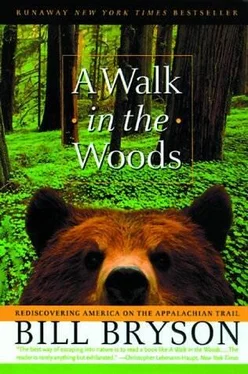Bill Bryson - A Walk In The Woods
Здесь есть возможность читать онлайн «Bill Bryson - A Walk In The Woods» весь текст электронной книги совершенно бесплатно (целиком полную версию без сокращений). В некоторых случаях можно слушать аудио, скачать через торрент в формате fb2 и присутствует краткое содержание. Жанр: Современная проза, на английском языке. Описание произведения, (предисловие) а так же отзывы посетителей доступны на портале библиотеки ЛибКат.
- Название:A Walk In The Woods
- Автор:
- Жанр:
- Год:неизвестен
- ISBN:нет данных
- Рейтинг книги:4 / 5. Голосов: 1
-
Избранное:Добавить в избранное
- Отзывы:
-
Ваша оценка:
- 80
- 1
- 2
- 3
- 4
- 5
A Walk In The Woods: краткое содержание, описание и аннотация
Предлагаем к чтению аннотацию, описание, краткое содержание или предисловие (зависит от того, что написал сам автор книги «A Walk In The Woods»). Если вы не нашли необходимую информацию о книге — напишите в комментариях, мы постараемся отыскать её.
A Walk In The Woods — читать онлайн бесплатно полную книгу (весь текст) целиком
Ниже представлен текст книги, разбитый по страницам. Система сохранения места последней прочитанной страницы, позволяет с удобством читать онлайн бесплатно книгу «A Walk In The Woods», без необходимости каждый раз заново искать на чём Вы остановились. Поставьте закладку, и сможете в любой момент перейти на страницу, на которой закончили чтение.
Интервал:
Закладка:
This ought to be a little surprising in a national park. I mean it’s not as if mussels are flinging themselves under the wheels of passing cars. Still, the Smokies seem to be in the process of losing most of their mussels. The National Park Service actually has something of a tradition of making things extinct. Bryce Canyon National Park is perhaps the most interesting-certainly the most striking-example. It was founded in 1923 and in less than half a century under the Park Service’s stewardship lost seven species of mammal-the white-tailed jackrabbit, prairie dog, pronghorn antelope, flying squirrel, beaver, red fox, and spotted skunk. Quite an achievement when you consider that these animals had survived in Bryce Canyon for tens of millions of years before the Park Service took an interest in them. Altogether, forty-two species of mammal have disappeared from America-s national parks this century.
Here in the Smokies, not far from where Katz and I now trod, the Park Service in 1957 decided to “reclaim” Abrams Creek, a tributary of the Little Tennessee River, for rainbow trout, even though rainbow trout had never been native to Abrams Creek. To that end, biologists dumped several drums of a poison called rotenone into fifteen miles of creek. Within hours, tens of thousands of dead fish were floating on the surface like autumn leaves. Among the thirty-one species of Abrams Creek fish that were wiped out was one called the smoky madtom, which scientists had never seen before. Thus, Park Service biologists managed the wonderfully unusual accomplishment of discovering and eradicating in the same instant a new species of fish. (In 1980, another colony of smoky madtoms was found in a nearby stream.)
Of course, that was forty years ago, and such foolishness would be unthinkable in these more enlightened times. Today the National Park Service employs a more casual approach to endangering wildlife: neglect. It spends almost nothing-less than 3 percent of its budget-on research of any type, which is why no one knows how many mussels are extinct or even why they are going extinct. Everywhere you look in the eastern forests, trees are dying in colossal numbers. In the Smokies, over 90 percent of Fraser firs-a noble tree, unique to the southern Appalachian highlands-are sick or dying, from a combination of acid rain and the depredations of a moth called the balsam woolly adelgid. Ask a park official what they are doing about it and he will say, “We are monitoring the situation closely.” For this, read: “We are watching them die.”
Or consider the grassy balds-treeless, meadowy expanses of mountaintop, up to 250 acres in extent, which are quite unique to the southern Appalachians. No one knows why the balds are there, or how long they have existed, or why they appear on some mountains but not others. Some believe they are natural features, perhaps relics of lightning fires, and some believe that they are man-made, burned or cleared to provide land for summer grazing. What is certain is that they are central to the character of the Smokies. To climb for hours through cool, dark forest and emerge at last onto the liberating open space of a sunny bald, under a dome of blue sky, with views to every horizon, is an experience not to be forgotten. But they are far more than just grassy curiosities. According to the writer Hiram Rogers, grassy balds cover just 0.015 percent of the Smokies landscape yet hold 29 percent of its flora. For unknown numbers of years they were used first by Indians and then by European settlers for grazing summer livestock, but now, with graziers banished and the Park Service doing nothing, woody species like hawthorn and blackberry are steadily reclaiming the mountaintops. Within twenty years, there may be no balds left in the Smokies. Ninety plant species have disappeared from the balds since the park was opened in the 1930s. At least twenty-five more are expected to go in the next few years. There is no plan to save them.
Now you might conclude from this that I don’t much admire the Park Service and its people, and that’s not quite so. I never met a ranger who wasn’t cheerful, dedicated, and generally well informed. (Mind you, I hardly ever met a ranger because most of them have been laid off, but the ones I encountered were entirely noble and good.) No, my problem is not with the people on the ground, it is with the Park Service itself. A lot of people point out in defense of the national parks that they have been starved of funds, and this is indubitably so. In constant dollars, the Park Service budget today is $200 million a year less than it was a decade ago. In consequence, even as visitor numbers have soared-from 79 million in 1960 to almost 270 million today-campsites and interpretation centers have been shut, warden numbers slashed, and essential maintenance deferred to a positively ludicrous degree. By 1997, the repair backlog for the national parks had reached $6 billion. All quite scandalous. But consider this. In 1991, as its trees were dying, its buildings crumbling, its visitors being turned away from campgrounds it could not afford to keep open, and its employees being laid off in record numbers, the National Park Service threw a seventy-fifth anniversary party for itself in Vail, Colorado. It spent $500,000 on the event. That may not be quite as moronically negligent as tipping hundreds of gallons of poison into a wilderness stream, but it is certainly in the right spirit.
But, hey, let’s not lose our perspective here. The Smokies achieved their natural splendor without the guidance of a national park service and don’t actually need it now. Indeed, given the Park Service’s bizarre and erratic behavior throughout its history (here’s another one for you: in the 1960s it invited the Walt Disney Corporation to build an amusement complex in Sequoia National Park in California) it is perhaps not an altogether bad idea to starve it of funds. I am almost certain that if that $200 million a year were restored to the budget, nearly all of it would go into building more parking lots and RV hookups, not into saving trees and certainly not into restoring the precious, lovely grassy balds. It is actually Park Service policy to let the balds vanish. Having gotten everyone in a lather by interfering with nature for years, it has decided now not to interfere with nature at all, even when that interference would be demonstrably beneficial. I tell you, these people are a wonder.
Dusk was settling in when we reached Birch Spring Gap Shelter, standing on a slope beside a muddy stream a couple of hundred feet downhill from the trail. In the silvery half-light, it looked wonderful. In contrast to the utilitarian plywood structures found elsewhere on the trail, the shelters of the Smokies were solidly built of stone in an intentionally quaint, rustic style, so from a distance Birch Spring Gap Shelter had the snug, homey, inviting look of a cabin. Up close, however, it was somewhat less enthralling. The interior was dark and leaky, with a mud floor like chocolate pudding, a cramped and filthy sleeping platform, and scraps of wet litter everywhere. Water ran down the inside of the walls and trickled into pools on the sleeping ledge. Outside there was no picnic table, as at most other shelters, and no privy. Even by the austere standards of the Appalachian Trail, this was grim. But at least we had it to ourselves.
Like most AT shelters, it had an open front (I never really understood the thinking behind this-what principle of design or maintenance necessitated leaving one whole side, and all the occupants, open to the elements?), but this one was covered with a modern chain-link fence. A sign on the fence said:“BEARS ARE ACTIVE IN THIS AREA. DO NOT LEAVE DOOR OPEN.” Interested to see just how active, I had a look at the shelter register while Katz boiled water for noodles. Every shelter has a register in which visitors make diarylike entries on the weather, the trail conditions, or their state of mind, if any, and note any unusual occurrences. This one mentioned only a couple of odd bearlike noises outside in the night, but what really caught the attention of the shelter’s chroniclers was the unusual liveliness of its resident mice and even rats.
Читать дальшеИнтервал:
Закладка:
Похожие книги на «A Walk In The Woods»
Представляем Вашему вниманию похожие книги на «A Walk In The Woods» списком для выбора. Мы отобрали схожую по названию и смыслу литературу в надежде предоставить читателям больше вариантов отыскать новые, интересные, ещё непрочитанные произведения.
Обсуждение, отзывы о книге «A Walk In The Woods» и просто собственные мнения читателей. Оставьте ваши комментарии, напишите, что Вы думаете о произведении, его смысле или главных героях. Укажите что конкретно понравилось, а что нет, и почему Вы так считаете.












